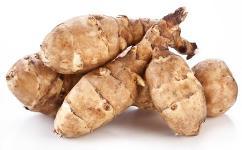(Adapted from the original source: GezondNu en http://www.groentenenfruit.nl)
Do you fancy cabbage, kale, root- and warm vegetables, rather than a cold salad this winter? Then read on! And guess what? They also happen to be the healthiest winter vegetables (in Europe). Some veggies are a bit difficult to get, but it’s certainly worth going to the trouble, because they’re packed with goodness!
Topinambour (Jerusalem artichoke)
The topinambour contains lots of vitamins, minerals, and fibre, and very few calories! Make it your best friend, as it stimulates calcium absorption in the body, protecting your bones from osteoporosis! I have to admit, though, I had never tried this root vegetable before – shame on me as a nutritionist! But to be honest, they do look a little scary, don’t they? But this week, I tried them and was pleasantly surprised by how yummy they actually are! What a lovely, subtle nutty flavour – and they’re so crisp if you eat them raw and thinly-sliced. What an absolutely great discovery! I ate it raw with some roasted hazelnut oil by the way – and it was delicious. It really doesn’t need much dressing up at all!
Cauliflower
Packed with vitamin C and calcium, cauliflower’s polyphenols – which, in fact, give it its particular flavour – are what we call ‘bio-active substances’ that may reduce the risk of cancer – as is typical of all plant substances in the same family.
Kale
Kale is – with its Vitamin C and E, beta carotene, iron and calcium content – the absolute healthiest winter vegetable! It’s above all also full of fibres. Use it in the place of spinach in your everyday recipes, or try them in chip form – it couldn’t be easier: Tear big pieces of kale off the centre stem, put them in a bowl, add a few tablespoons of olive oil, a sprinkling of sea salt, and they’re ready to go! Just put them in the oven at 160C for about 15 minutes, and they’ll get completely crisp. The kids love them!
Kohlrabi
Part of the cabbage family, kohlrabi is rich in calcium, beta carotene, vitamin C and potassium. It’s also poor in calories. Kohlrabi can be eaten raw as well as cooked; try it thinly sliced in salads, or cut up and roasted in the oven. Try Googling ‟kohlrabi recipes” and you’ll see that there are lots of options!
Sweet in taste, parsnips are full of iron, potassium, copper, manganese, phosphorous, calcium, essential oils, folic acid and vitamins E, C and B. Parsnip essential oil can bring relief to stomach and intestinal complaints, and is also used to treat a number of health complaints such as kidney disorders, heart problems, blood pressure, obesity, anaemia and asthma – to name but a few!
Leek
In the allium family, leeks contain a unique combination of flavonoids. Rich in vitamins A, B1 and B2, C and E, it is also full of potassium, phosphorous, and manganese. Rich in sulphur, they are known to inhibit infection and are especially useful in preventing kidney stones from developing.
Red cabbage
The anthocyans (purple colour) in red cabbage have inflammation-inhibiting qualities and an anti-oxidant effect. Eat red cabbage raw to benefit from the most vitamins, as the vitamin content diminishes when it is cook. It is rich in iron, as well, making it an especially useful friend for us women!
Black salsify contains potassium, magnesium, calcium, phosphorus, iron, and copper. This vegetable has a relaxing effect, improves your night’s rest, and nurtures your hair from the inside out!
Brussels Sprouts
I can safely say that Brussels sprouts must be every single Dutch child’s least favourite vegetable (at least for me! But hey, they are packed with health benefits, so our parents were right to force us to eat them! Brussels sprouts contain twice as much vitamin C as an orange, and are rich in the B-vitamins, as well as minerals. Try them oven-roasted with balsamic vinegar and sea salt – they’re divine!
Light beige in colour, parsley root is a variety of the parsley family, reminiscent taste-wise of parsnips and celeriac. The root is rich in carotene, vitamins B2 and C, and strengthens the immune system, boosting your vitamin C absorption. Usually eaten cooked, it can also be eaten raw.


